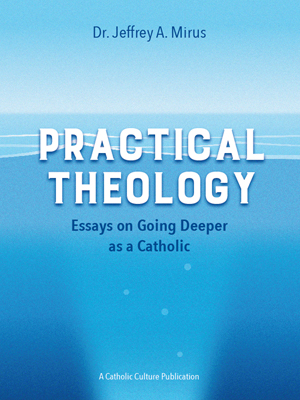Reclaiming Catholic Universities: The Challenge of Phase 1
By Dr. Jeff Mirus ( bio - articles - email ) | Mar 10, 2016
Clearly we are in the first phase of reclaiming prominent nominally Catholic universities for Christ. In this first phase, bishops—including the local bishop—feel free to speak out against the more obvious decisions of the university administration that undermine the Faith. This happened to Georgetown University a few days ago when the Archdiocese of Washington issued a statement lamenting the school’s invitation to the President of Planned Parenthood to speak.
Free eBook:

|
| Free eBook: Practical Theology |
It also began happening ten years ago to the University of Notre Dame, when the Bishop of South Bend criticized the school for promoting the “Vagina Monologues” (see The Monologues Revisited: Bishop D'Arcy and Notre Dame). A few years later, Bishop John D’Arcy refused to attend the commencement exercises because the most pro-abortion President in history had been invited to speak and receive an honorary degree (see Notre Dame: Shaking the Foundations).
Outside the mainstream, of course, there has been considerable progress beyond Phase 1. A small number of schools never went far wrong, and new college foundations beginning in the mid-1970s deliberately countered the secularist trend (my own involvement with Christendom College is only one of a half-dozen examples). A few older schools (such as Franciscan University and Belmont Abbey College) have been brought back, and even a number of more significant universities have been much improved (I think, for example, of Providence College and even Catholic University).
But the American Jesuits, who are very far gone when it comes to Catholic fidelity, control far too much of American Catholic higher education (Georgetown being somewhat paradigmatic), and a number of non-Jesuit flagship universities such as Notre Dame (Congregation of the Holy Cross) remain committed to constant self-evaluation according to the dominant concepts of the secular academy.
For these, and a huge number of smaller colleges and universities just like them, we are very definitely in Phase 1—the phase in which bishops at least have the courage to draw theoretical lines, even if the hierarchy as a whole has no idea of how to make these academic institutions more Catholic—despite the episcopal license required to teach theology since the 1990s. What is particularly interesting in the Georgetown case is the willingness of a Cardinal halfway around the world to add fuel to the critical fire. This is a promising development spurred by social media.
The collapse of Catholic higher education was in the making well before 1950, but the full academic defection from the Faith was not obvious until the 1960s. It is sad, to be sure, that forty-odd years after lay leaders thoroughly understood the problem, there is still no effective solution in sight. The authentic renewal of Catholic higher education (as outlined in John Paul II’s Ex Corde Ecclesiae in 1990) has been painfully slow. One of the most effective organizations working on the problem is The Cardinal Newman Society but, realistically speaking, the Cardinal Newman Society is in somewhat the same case as CatholicCulture.org—playing an important role, from a decidedly weak position, that could be rendered unnecessary overnight by an effective renewal of the whole Church from the top down.
But at least the very existence of Georgetown University, in its present form, is a stern reminder that we have not got past Phase 1, and for a very important reason: Namely, because without Christ this is an unequal contest. Truly it is as St. Paul said: “We are not contending against flesh and blood” (Eph 6:12). This means, among other things, that nothing ever gets better through mere inertia, just as nothing ever gets better without prayer for God’s help. Perhaps it also means that enough Catholic leaders are not yet as wise as serpents nor even as innocent as doves.
In fact, the primary challenge of Phase 1 is to develop spiritual strength. This is the responsibility not only of all who read these words, but also of every bishop, every priest, every religious, every administrator, every professor, and every student:
Finally, be strong in the Lord and in the strength of his might. Put on the whole armor of God, that you may be able to stand against the wiles of the devil. For we are not contending against flesh and blood, but against the principalities, against the powers, against the world rulers of this present darkness, against the spiritual hosts of wickedness in the heavenly places. Therefore take the whole armor of God, that you may be able to withstand in the evil day, and having done all, to stand. Stand therefore, having girded your loins with truth, and having put on the breastplate of righteousness, and having shod your feet with the equipment of the gospel of peace; besides all these, taking the shield of faith, with which you can quench all the flaming darts of the evil one. And take the helmet of salvation, and the sword of the Spirit, which is the word of God. [Eph 6:10-17]
All comments are moderated. To lighten our editing burden, only current donors are allowed to Sound Off. If you are a current donor, log in to see the comment form; otherwise please support our work, and Sound Off!








